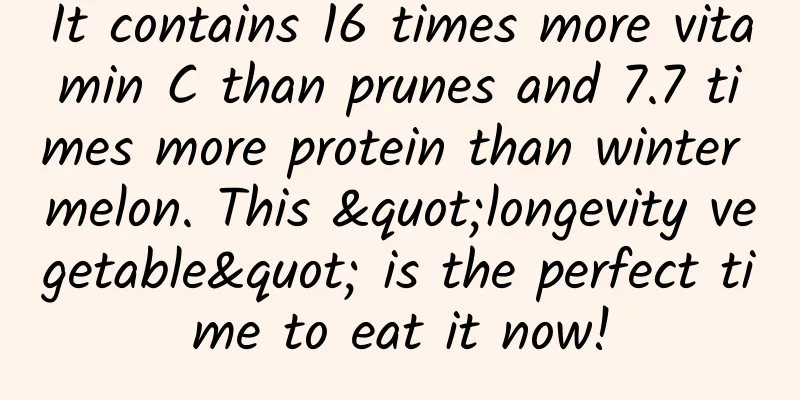It contains 16 times more vitamin C than prunes and 7.7 times more protein than winter melon. This "longevity vegetable" is the perfect time to eat it now!

|
There is a kind of wild vegetable that often appears in the countryside, fields, and ditches. In the past, people would feed it to pigs, so it was once considered "pig food"; however, because of its extremely high nutritional value, it is also called "longevity vegetable." It is a wild vegetable with strong vitality - Purslane. Nutritional value of purslane When describing Purslane, Li Shizhen commented that "its leaves are as rough as horse teeth, and its nature is smooth and astringent like amaranth", which is how Purslane got its name. Purslane is a succulent plant with thick, succulent, emerald green leaves that may seem ordinary. It has long been considered a weed because it grows quickly and reproduces easily. In recent years, as people pay more attention to healthy eating, the nutritional value of purslane has gradually been discovered, and it has become a highly popular health vegetable. 1. Omega-3 fatty acids The most outstanding nutritional value of purslane is its high content of ω-3 fatty acids. It should be noted that the content of ω-3 fatty acids in plant foods is very low. 100 grams of fresh purslane leaves contain about 300-400 mg of ω-3 fatty acids, which is higher than that of sea bass and hairtail, and about twice that of hairtail. Most plant foods do not contain ω-3 fatty acids, so purslane is also considered one of the richest plant sources of α-linolenic acid. Alpha-linolenic acid is an omega-3 fatty acid that is essential for human growth, development, prevention of a variety of cardiovascular diseases, and maintaining a healthy immune system. Since omega-3 fatty acids are generally lacking in the diet, many people cultivate purslane for consumption. For people who do not eat fish and do not take additional fish oil or algae oil, purslane is an excellent food for supplementing omega-3 fatty acids. 2. Protein Every 100 grams of purslane contains about 2.3g of protein, which is relatively high among plant foods and comparable to fresh bean vegetables such as lentils and beans. It is also 7.7 times that of winter melon, 3.3 times that of white radish and pumpkin, and 2.9 times that of fresh kidney beans and round eggplants. 3. Vitamins Purslane also has a considerable vitamin content, especially vitamin C, which is about 23 mg per 100 grams, which is comparable to the level of citrus fruits, 16.4 times that of prunes, 7.7 times that of apples and pitaya, and 5.8 times that of apricots, far exceeding many common fruits and vegetables. Vitamin C, as a powerful antioxidant, can protect the body from damage by free radicals and prevent a variety of diseases. In addition to vitamin C, purslane is also rich in antioxidants such as beta-carotene and vitamin E, which play an important role in protecting vision, skin health, and immune function. 4. Minerals In terms of minerals, purslane is no slouch. It is rich in calcium, with about 87 mg of calcium per 100 g, making it a good calcium-supplementing vegetable. It is rich in potassium (494 mg/100 g) and magnesium (68 mg/100 g), which are minerals that are good for lowering blood pressure and heart health. In addition to the above nutritional highlights, purslane contains norepinephrine, which can promote the secretion of insulin and help lower blood sugar. In addition, the sticky ingredients in purslane are actually polysaccharides, which also help slow the rise of blood sugar. A systematic review and meta-analysis pointed out that purslane can significantly reduce plasma fasting blood sugar levels. Two things to note when eating purslane Although purslane is rich in nutrients, you must pay attention to two points when eating it, otherwise it may bring health risks. 1. Purslane has a high oxalic acid content, so it is recommended to blanch it first Purslane contains a high content of oxalic acid, up to 1460 mg/100 g. This substance easily combines with calcium in the human body to form calcium oxalate precipitate, affecting the absorption and utilization of calcium and increasing the risk of stones. Therefore, purslane should be blanched in boiling water before consumption to remove most of the oxalic acid. 2. Don’t eat wild purslane randomly, as it may contain excessive amounts of heavy metals Wild purslane on the roadside is contaminated by pollutants such as automobile exhaust and pesticides, and may contain excessive heavy metals or other harmful substances. These harmful substances may cause damage to the human body, so you should avoid eating wild purslane on the roadside. According to the experimental data of "Determination of Copper, Cadmium and Lead Contents in 7 Wild Vegetables and Evaluation of Their Pollution Status" from the College of Agriculture of South China University of Tropical Agriculture, the content of lead, cadmium and copper in purslane are 21 times, 4 times and 1.8 times the maximum residual amounts, respectively. In addition, it should be noted that some people cannot identify purslane on the roadside or in the park, and may confuse it with some similar-looking plants, which may lead to poisoning risks if eaten by mistake. Therefore, if you need to eat purslane, it is recommended to buy it through formal channels or grow it yourself. |
>>: Our children cannot be killed by smoke.
Recommend
What is the cause of Phalaenopsis root rot? How to solve Phalaenopsis root rot?
With the improvement of living standards, more an...
If these signs appear in the upper body, it is likely to be lung cancer
Whether in the world or in China, the incidence a...
Spring sleepiness, summer fatigue, autumn naps, have your children gotten enough sleep?
For most parents, the healthy growth of their chi...
Sexual indifference after childbirth
Many couples have this experience: after having c...
Is it good for women to drink Astragalus extract?
Due to women's special physiological phenomen...
Six hormones to see polycystic ovary
Generally, when we look at the data and see that ...
Can I have sex on the first day of my period?
Girls have their periods every month, and they ar...
Pelvic Infertility
In modern society, many people are troubled by in...
Skin color after cupping is a barometer of health
Cupping is a traditional Chinese medicine treatme...
What is the reason for the thick yellow leucorrhea?
Previously, a female friend told me that her leuc...
What is the normal value of progesterone during menstruation?
Menstruation is a unique physiological phenomenon...
Coughing during confinement can cause uterine prolapse
Although bearing children is a woman's noble ...
What are the treatments for mastitis suppuration?
If there is adenitis and suppuration has occurred...
Can I get pregnant with chronic enteritis?
We all know that pregnancy is an exciting thing f...









